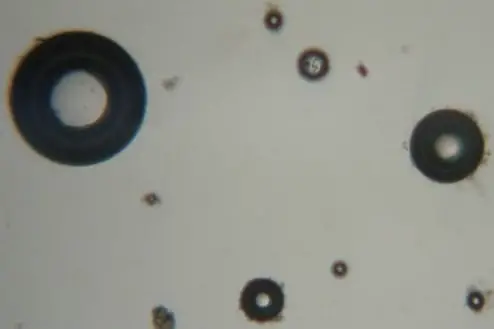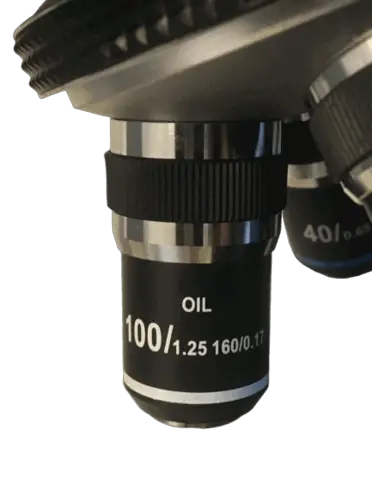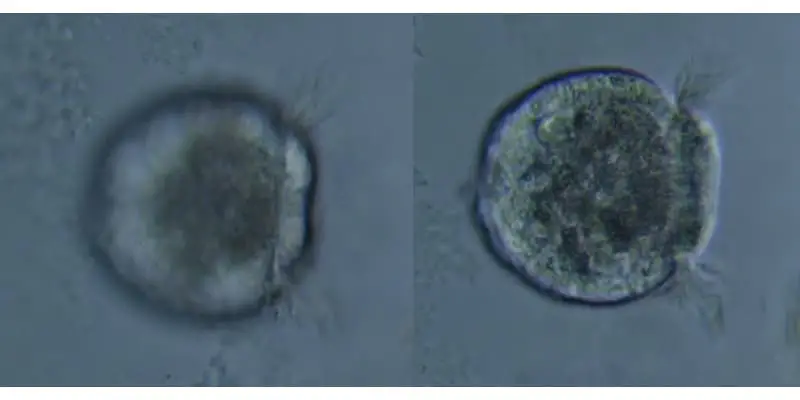Microscopes are fun to use but can sometimes be frustrating if you don’t know how to bring something into focus. Knowing the limits of the microscope and knowing some of the common mistakes and things to troubleshoot can save you some time a grief. So how does one focus a microscope?
To focus a microscope, rotate to the lowest-power objective, and place your sample under the stage clips. Play with the magnification using the coarse adjustment knob and move your slide around until it is centered. When switching to a higher-power objective, focus using the fine adjustment knob until the edges, and specific features of interest become sharp and clear.
This article will cover the ins and outs of focusing a microscope and some common issues encountered when trying to focus on a specimen. It will also detail some of the differences between wet and dry mount slides and the parts of a microscope involved in act of focusing a microscope.
Focus on a Prepared Slide
Pre-prepared slides are slides that have specimens already collected for you locked inside of them. You can buy them off of Amazon from companies like National Geographic or Celestron, such as this Celestron Prepared Microscope Slides (100-Piece Set).
Focusing on a slide takes patience. You may find yourself tempted to turn to the highest power objective and start twisting both focus knobs right away. But resist the temptation.
Whether focusing on a dry or wet mount slide, always start on the lowest power objective. By putting a microscope on high power, you are basically “zooming in” on the specimen, making it easier to overlook important areas and making it harder to find the sample in your field of view. Focus using the coarse adjustment knob first, then make adjustments with the fine adjustment knob later on higher power objectives. If you want to go to a higher power objective, do so, then focus again with the fine focus knob only.

If you use the coarse adjustment knob under a higher power objective the stage may raise or lower too rapidly for you to ever bring the microscope into focus and resolve the image. Additionally, you risk damaging the objective lens if you use coarse adjustment because you could raise the stage too rapidly and accidently press the slide into the objective. Objectives are one of if not the most expensive piece of the microscope so you definitely want to avoid this!
Steps to Focus a Microscope
- Rotate to the lowest-power objective lens. You want to make sure that you can look through the lens without being too concentrated on one area. If it’s too powered, you won’t be able to make out anything through the lens. Rotate it down, then proceed to the next step.
- Place your slide label-side up on the stage: clip it on with the stage clips. Every microscope comes with one or more clips that can be used to hold slides. Never try to use DIY clips since they’re not stable. Stage clips are designed to hold the delicate glass slides without causing damage.
- Use the coarse focus knob to focus on your slide as best you can. Take your time and make sure that the lens isn’t too close to the slide. Contrary to popular belief, getting too close to a microscope or sliding it too close to the lens can make it harder to see. It reduces the field of vision.
- If nothing can be seen, try using the X-Y translational knobs to move the slide until you see the specimen, then try reducing the light source – this can be done by closing the iris the diaphragm below the stage. You never know if the slide isn’t centered unless you look with your eyes rather than the microscope. If it’s off-center, you’ll never get a glimpse.
- If you are seeing some spherical aberration try using a green filter. You can use a filter by swinging out the filter rack below the stage, placing the filter into the rack and then re-engaging the filter rack back into place. For more on microscope filters see this post.
- When done looking at low power, rotate to the medium or high-power objective lens, then focus using the fine focus knob. You’ll be able to see much more of the specimen in higher detail.
This video will show you step by step how to use a microscope including focusing the microscope.
That’s all there is to it! Focusing a microscope is fairly simple once you know how to follow the previously mentioned six-step process. Keep in mind that, when using a microscope, it’s important to take your time and move slowly. Sudden changes can cause drastic alterations to the slide and what you’re able to see.
If you have any other questions about how to focus a microscope or you’d like to see general tips on the topic, read on.
Microscope Focusing FAQ
- I can see nothing; everything is dark. Make sure your microscope is plugged in and switched on, and all the objective lenses are screwed on properly. Also, check the light source and see if it is working, or if the light burned out. You might have luck using another light source.
- I can’t find anything on low power. Make sure you’ve centered the slide and turned the coarse adjustment knob to see if anything comes into focus. Off-center slides are the most common culprit. Look from all sides to ensure that the slide is perfectly centered, then take another look.
- When I switched to a higher power, everything disappeared. This means your slide is not centered. Return to the lower-power objective and center it properly.
- The image is blurry on all powers. Clean your objective lens. Small scratches could permanently blur your lenses, so use caution when moving the microscope or raising the stage too high. Consider getting a carrying case if you don’t already have one.

- The image is blurry on one particular power. Clean that objective lens with lens paper. Again, scratches might be the cause of the issue. Wipe it down, buff it out, and see if you can get a clearer image.
- I see lots of circles with dark rings. These are air bubbles that were possibly caused by the procedure used to create the wet mount. For a complete guide on wet mounting slides see this post.

Limits of Magnification
The maximum useful magnification for microscopes is around 1000x-1200x due to the limits of the magnifying power of light. At a certain point, the image will keep getting bigger as you zoom in, but the resolution will stay equally as bad. To learn more about magnification see Microscope Magnification: Explained.
If you have engaged your highest power objective but are unable to bring it into focus that is because typically the highest power objective on a microscope is a 100X oil immersion objective. These objectives are specialized objectives that require the objective to have a drop of immersion oil between the objective lens and the slide coverslip over the specimen on the slide. You will not be able to focus this objective without immersion oil. For a complete guide on how to use immersion oil and for the reason why you need immersion oil to bring something into focus with this objective see this post.

Takeaways
Focusing a microscope isn’t too hard if one follows the suggestions laid out in this article. Always start out on the lowest-power objective and use the coarse focus knob first. Focusing on wet and dry mount samples works the same way, although preparing them is different.
Do not use excessive magnification, as the zoom will increase while the resolution will not. If you are still having no luck focusing your microscope, consider taking it in for repair. Small scratches on the lens or corroded knobs can alter its performance. You could save quite a bit of time and money by calling a professional to take a look. Follow the proper maintenance procedures and your microscope will last for many years to come.

